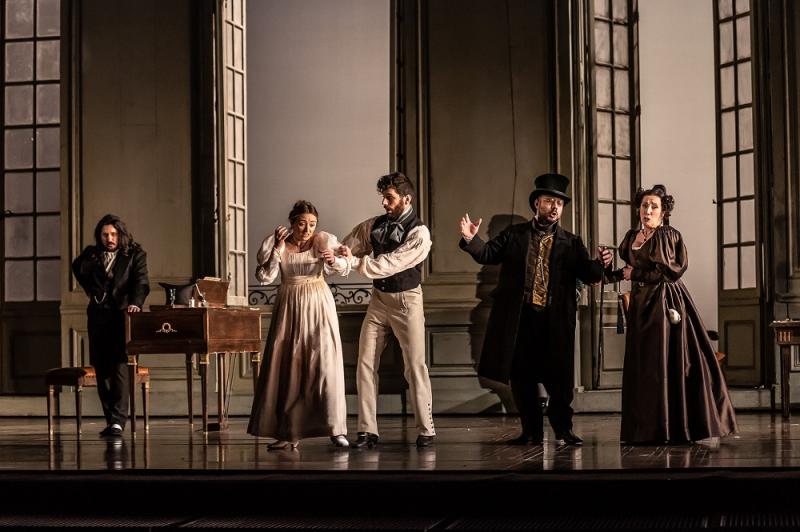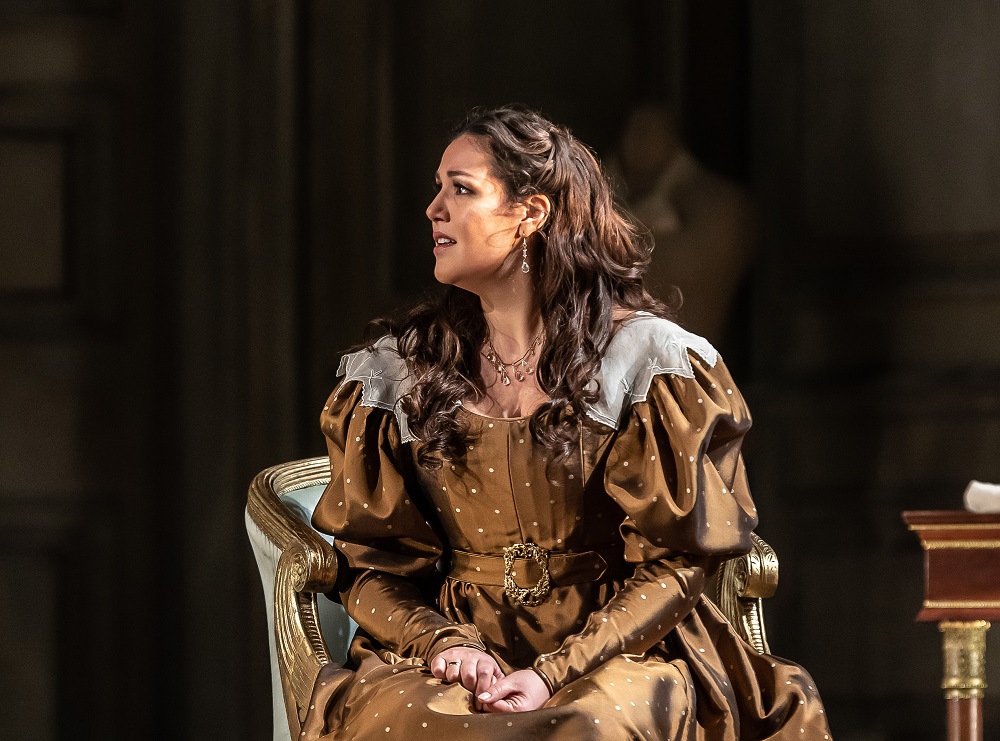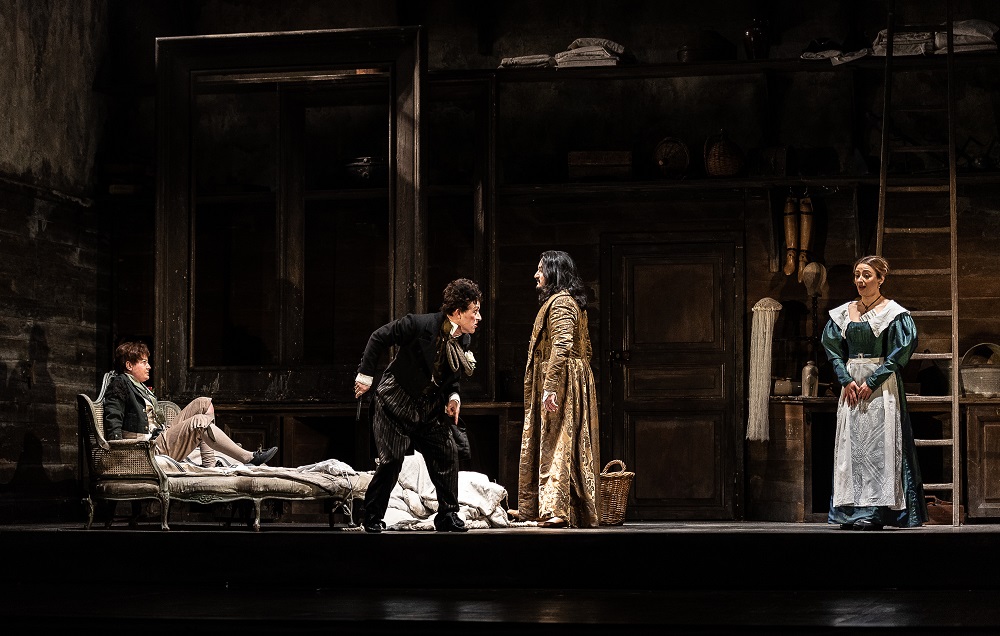Le nozze di Figaro, Royal Opera review - New Year champagne | reviews, news & interviews
Le nozze di Figaro, Royal Opera review - New Year champagne
Le nozze di Figaro, Royal Opera review - New Year champagne
Perfect ensembles and recits with Antonio Pappano's return as conductor and fortepianist

One of the galvanizing wonders of the operatic world happened when David McVicar’s production of Mozart’s The Marriage of Figaro was new, back in 2006: the sight and sound of Royal Opera music director Antonio Pappano in seamless dual role as conductor and recitative fortepianist.
Now he’s back, and better than ever, with more than a gimmick to offer in this latest revival: there are no big names in the cast, but six out of the eight principals are Italian – this Figaro is, of course, sung to Lorenzo Da Ponte’s original, dazzling adaptation of Beaumarchais’ play – and young when the characters so require.
The pace has an absolute rightness, keeping company with the Mozartian perfections of the late, great Mackerras and Haitink. String figurations are superbly articulated and, when necessary, biting (there’s a lot of anger in this drama); oboe and bassoon especially add perfection to play-acting serenades. Riccardo Muti once told me in interview that Mozart/Da Ponte recitatives sung by Italians flow like "rivers without rocks in the middle". As they do from the off here, enriched by Pappano’s judicious eddies and the space he gives to his soloists.  Perhaps, then, it’s not surprising that arguably the loveliest moment of the performance comes when Giulia Semenzato’s Susanna asks, in the rapturous aftermath of the Act Three Sextet revealing her Figaro as the long-lost son of erstwhile opponents Marzelline and Bartolo, “who could be as happy as I am?,” and finds a threefold echo of “I am” from husband- and in-laws-to-be. Pappano allows her an exquisite ornamentation here, and in the ineffably lovely “Deh, vieni non tardar”, ostensibly (faked) to her lecherous master but actually to the eavesdropping Figaro.
Perhaps, then, it’s not surprising that arguably the loveliest moment of the performance comes when Giulia Semenzato’s Susanna asks, in the rapturous aftermath of the Act Three Sextet revealing her Figaro as the long-lost son of erstwhile opponents Marzelline and Bartolo, “who could be as happy as I am?,” and finds a threefold echo of “I am” from husband- and in-laws-to-be. Pappano allows her an exquisite ornamentation here, and in the ineffably lovely “Deh, vieni non tardar”, ostensibly (faked) to her lecherous master but actually to the eavesdropping Figaro.
It’s the highlight of the solo set-pieces; the others are good, perhaps not great, but the young Figaro (handsome, musically very sharp-witted Riccardo Fassi), Count (Germán E. Alcántara, velvet-toned Argentinian graduate of the Royal Opera’s Jette Parker Young Artists Programme, replacing an Italian at the last minute) and Countess (the tall, poised Federica Lombardi, pictured above, who’s recorded Verdi’s Desdemona for Pappano) wax in confidence as the “mad day” in the Almaviva household unfolds. Better still, we get to know who they, and Hanna Hipp’s Cherubino, who begins rather cloudy-toned but offers ideal acting aplomb (pictured below with,Gregory Bonfatti's Don Basilio, Alcántara and Semenzato), are as people.  Gianluca Buratto’s Bartolo ups the volume level in his impressive “revenge” aria, and Monica Bacelli – once a graceful Cherubino – finds more interest than ever as the testy Marcellina, so much so that we really want to hear her Act Four aria (as usual, that and Basilio's number are casualties – probably right for the pacing of the evening). McVicar's update from the 1780s to the 19th century still has too much group serving-staff business and though Tanya McCallin's stage pictures look handsome, the side-lighting too often leaves faces in shadow. But everything works where it matters. We hit comic-sensuous heaven above all in the Act Two trio and the two big finales; the one in the Countess’s apartment has that authentic stamp of treading air on Cloud Nine from the start. No greater pleasure to dispel the cares of an ominous-looking 2022 could possibly be imagined.
Gianluca Buratto’s Bartolo ups the volume level in his impressive “revenge” aria, and Monica Bacelli – once a graceful Cherubino – finds more interest than ever as the testy Marcellina, so much so that we really want to hear her Act Four aria (as usual, that and Basilio's number are casualties – probably right for the pacing of the evening). McVicar's update from the 1780s to the 19th century still has too much group serving-staff business and though Tanya McCallin's stage pictures look handsome, the side-lighting too often leaves faces in shadow. But everything works where it matters. We hit comic-sensuous heaven above all in the Act Two trio and the two big finales; the one in the Countess’s apartment has that authentic stamp of treading air on Cloud Nine from the start. No greater pleasure to dispel the cares of an ominous-looking 2022 could possibly be imagined.
- Le nozze di Figaro at the Royal Opera until 27 January. Christopher Willis conducts the performances on 25 and 27 January
- More opera reviews on theartsdesk
rating
Explore topics
Share this article
Add comment
The future of Arts Journalism
You can stop theartsdesk.com closing!
We urgently need financing to survive. Our fundraising drive has thus far raised £49,000 but we need to reach £100,000 or we will be forced to close. Please contribute here: https://gofund.me/c3f6033d
And if you can forward this information to anyone who might assist, we’d be grateful.

Subscribe to theartsdesk.com
Thank you for continuing to read our work on theartsdesk.com. For unlimited access to every article in its entirety, including our archive of more than 15,000 pieces, we're asking for £5 per month or £40 per year. We feel it's a very good deal, and hope you do too.
To take a subscription now simply click here.
And if you're looking for that extra gift for a friend or family member, why not treat them to a theartsdesk.com gift subscription?
more Opera
 Albert Herring, English National Opera review - a great comedy with depths fully realised
Britten’s delight was never made for the Coliseum, but it works on its first outing there
Albert Herring, English National Opera review - a great comedy with depths fully realised
Britten’s delight was never made for the Coliseum, but it works on its first outing there
 Carmen, English National Opera review - not quite dangerous
Hopes for Niamh O’Sullivan only partly fulfilled, though much good singing throughout
Carmen, English National Opera review - not quite dangerous
Hopes for Niamh O’Sullivan only partly fulfilled, though much good singing throughout
 Giustino, Linbury Theatre review - a stylish account of a slight opera
Gods, mortals and monsters do battle in Handel's charming drama
Giustino, Linbury Theatre review - a stylish account of a slight opera
Gods, mortals and monsters do battle in Handel's charming drama
 Susanna, Opera North review - hybrid staging of a Handel oratorio
Dance and signing complement outstanding singing in a story of virtue rewarded
Susanna, Opera North review - hybrid staging of a Handel oratorio
Dance and signing complement outstanding singing in a story of virtue rewarded
 Ariodante, Opéra Garnier, Paris review - a blast of Baroque beauty
A near-perfect night at the opera
Ariodante, Opéra Garnier, Paris review - a blast of Baroque beauty
A near-perfect night at the opera
 Cinderella/La Cenerentola, English National Opera review - the truth behind the tinsel
Appealing performances cut through hyperactive stagecraft
Cinderella/La Cenerentola, English National Opera review - the truth behind the tinsel
Appealing performances cut through hyperactive stagecraft
 Tosca, Royal Opera review - Ailyn Pérez steps in as the most vivid of divas
Jakub Hrůša’s multicoloured Puccini last night found a soprano to match
Tosca, Royal Opera review - Ailyn Pérez steps in as the most vivid of divas
Jakub Hrůša’s multicoloured Puccini last night found a soprano to match
 Tosca, Welsh National Opera review - a great company reduced to brilliance
The old warhorse made special by the basics
Tosca, Welsh National Opera review - a great company reduced to brilliance
The old warhorse made special by the basics
 BBC Proms: The Marriage of Figaro, Glyndebourne Festival review - merriment and menace
Strong Proms transfer for a robust and affecting show
BBC Proms: The Marriage of Figaro, Glyndebourne Festival review - merriment and menace
Strong Proms transfer for a robust and affecting show
 BBC Proms: Suor Angelica, LSO, Pappano review - earthly passion, heavenly grief
A Sister to remember blesses Puccini's convent tragedy
BBC Proms: Suor Angelica, LSO, Pappano review - earthly passion, heavenly grief
A Sister to remember blesses Puccini's convent tragedy
 Orpheus and Eurydice, Opera Queensland/SCO, Edinburgh International Festival 2025 review - dazzling, but distracting
Eye-popping acrobatics don’t always assist in Gluck’s quest for operatic truth
Orpheus and Eurydice, Opera Queensland/SCO, Edinburgh International Festival 2025 review - dazzling, but distracting
Eye-popping acrobatics don’t always assist in Gluck’s quest for operatic truth
 MARS, Irish National Opera review - silly space oddity with fun stretches
Cast, orchestra and production give Jennifer Walshe’s bold collage their all
MARS, Irish National Opera review - silly space oddity with fun stretches
Cast, orchestra and production give Jennifer Walshe’s bold collage their all

Comments
Bartolo doesn't have a
Indeed, brainslip, thanks, I
Indeed, brainslip, thanks, I'll correct that.
I've seen this production a